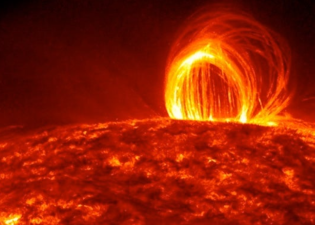Every 11 years, the Sun enters a new cycle: the pattern of sunspots appearing and disappearing on our star marks its activity level.
Every 11 years, the Sun enters a new cycle: the pattern of sunspots appearing and disappearing on our star marks its activity level.
Each cycle is like an arched curve, with peaks (when the solar activity is the strongest and there are the most sunspots) and valleys (when the solar activity is the weakest and there are the fewest sunspots). The 25th solar cycle has begun. Scientists from NASA and the National Oceanic and Atmospheric Administration (NOAA) have confirmed that the Sun is officially nine months into this cycle.
Experts believe that the new cycle may be very similar to the previous one (2008-2019), which was quite calm. However, this does not mean that this cycle is "risk-free".
An international panel of experts from NASA and NOAA recently announced that the solar minimum occurred in December 2019, marking the beginning of a new solar cycle. As the solar minimum moves away from us, scientists expect that solar activity will gradually increase until reaching the next maximum in July 2025.

Space weather sounds like a prediction we Earthlings can easily ignore, but it actually has the potential to wreak havoc.
Stormy space weather means more intense electromagnetic activity on our favorite billowing hot air balloon, the Sun—which can disrupt the operation of satellites, power grids, and space travel.
Fortunately, researchers are predicting a period of relatively calm space weather as the Sun enters Solar Cycle 25—a smooth solar forecast is good news indeed.
The end of one solar cycle and the beginning of a new one is known as a solar minimum.
This is when the Sun's electromagnetic activity levels are at their lowest, and there are relatively few sunspots. When the Sun's hot gases swirl more vigorously, the number of sunspots increases and the Sun's magnetic field changes. This means that at the start of each new solar cycle, the Sun's north and south poles switch.
"The last cycle, Solar Cycle 24, was the fourth-weakest on record and the weakest in 100 years," said astronomer Carolyn Carolyn, of Space Systems Research Corporation and co-chair of the Solar Cycle 25 Forecast Panel.
But even the faint hum of the Sun in Cycle 24 can occasionally cause radio blackouts, air traffic control outages and power outages.
As Solar Cycle 25 progresses, sunspots and sudden bursts of solar energy, called solar flares, will become increasingly likely until July 2025, when solar activity reaches its expected peak maximum. The forecast panel expects this solar cycle to peak at about 115 sunspots, compared with 114 during the last solar maximum.
In addition to power infrastructure and satellites, solar forecasts are an important consideration for any manned program, researchers said.
